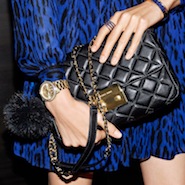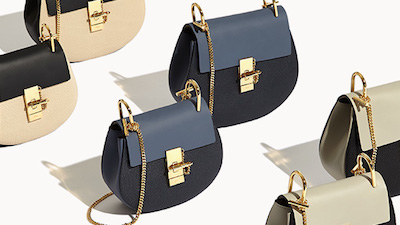Female consumers in the United States spent approximately $11.5 billion on handbags in 2015, according to a new report by The NPD Group and Stylitics.
The product category itself grew 5 percent in 2015 compared to the year prior, driven mainly by the discretionary spending power of the baby boomer generation. Handbag purchases made by millennials, ages 18- to 34-years old, however, only increased by 2 percent due to the shopping behavior the demographic exhibits, favoring a more considered buy rather than impulse or purchasing based on brand stature.
“The millennial customer is shopping for handbags very differently than other generations,” said Rohan Deuskar, CEO/co-founder of Stylitics.
“For example, this customer starts with specific product attributes, not brand, when looking for her next handbag, and invests more time and research in her purchase than brands and retailers realize,” he said. “These findings have been eye-opening for handbag sellers, and are having an immediate impact on their marketing, merchandizing and product development strategies.”
The NPD Group’s “The New Handbag Customer Revealed 2016” report was conducted in partnership with Stylitics. The report looks specifically at how female millennial consumers purchase handbags by examining their needs, aspirations, inspirations and triggers.
Handy handbags
To many consumers a handbag is not just an accessory, but an extension of her personality. A handbag can speak to a woman’s qualities and characteristics in ways different from her clothing or footwear.
As a result, 41 percent of millennial respondents weighed their handbag options carefully before making a purchase, thinking about which style was right for them for more than a month prior to committing. The report suggests that millennials’ handbag shopping journey more closely aligns with purchasing a vehicle than clothing.
The time spent considering their options makes millennial shoppers much different from generations prior, who may not have researched products extensively before making a decision. When in the market for a new handbag, millennial consumers first meditate on specific product attributions rather than on a particular brand.
With millennials being more inclined to research prior to purchase, this presents accessories retailers an opportunity to market, merchandize and develop product strategies that cater to this behavior pattern.
For 61 percent of millennial consumers the research phase of the handbag purchase journey is conducted online. While a well-curated and informative handbag description page is important to sway decisions, the bricks-and-mortar space will provide consumers with an opportunity to see, feel and try on a handbag.
The NPD Group suggests that handbag retailers position their in-store inventory front and center to serve as a signature of brand identity and style. This way, consumers who shop the brand can apply that signature to their personal look.
As with any product category, a worthwhile in-store experience may sway the consumer’s decision and lead to long-term loyalty.
When a consumer does narrow in one a particular handbag, she is much more interested in the item’s details, qualities and uniqueness. Brand is secondary across nearly all price points and styles.
For brands with smaller awareness radiuses, this can be beneficial, as the millennial consumer is much more open to buying from emerging and lesser-known labels. This has implications for established brands who may be more relaxed in culling the attention of millennial consumers hoping that their name or logo can speak for itself, gathering that promoting craftsmanship and quality.
Although three out of four consumers represent opportunity for handbag sellers, brands must acknowledge that the millennial generation is not as loyal to brand as the older generations. To counter this, brands must offer unique, well-crafted products and use in-store displays and social media channels for consumer outreach.
Make it yours
When The NPD Group and Stylitics asked survey respondents about the next bag type they will consider buying, one stated that it will be, “Colored leather. [A] small bag so it’s not too heavy. Brand doesn’t matter. Has to be high-quality and look unique in some way.”
Customization solutions have presented handbag makers with an easy way to take current product offerings unique to the purchaser through personalization.
Italy’s Fendi, for instance, has drawn inspiration from the timepiece industry by allowing the consumer to personalize the strap of her handbag.
Handbags are commonly referred to as the most personal aspect of a woman’s wardrobe, as a style can work to define her personality traits while also echoing a statement. The Fendi Strap You can be fixed to a number of the label’s iconic handbag styles, furthering a woman’s ability to make a personal statement with her bag of choice, from the shape to the handle (see story).

Fendi campaign with a handbag accessorized by a Strap You add-on
How millennial consumers approach handbag purchases have also impacted the retail strategies of leaders in the category.
For instance, U.S. fashion label Michael Kors plans to scale back department store retailing to protect the brand’s overall image and profits.
According to WWD, shares of Michael Kors increased 8.3 percent on Nov. 4, but despite the rising stock value for the second quarter of 2015, the brand has seen a dip in the department store channel. As a result Michael Kors will pull back its inventory in department stores mainly to avoid its merchandise being placed on sale by its retail partners.

Michael Kors handbag promotional image
A primary selling point for Michael Kors within the department store channel is the brand’s handbags.
While Michael Kors handbags have maintained popularity, the label has seen a trend among millennials that have resulted in the purchasing of smaller handbags. Due to the smaller size, the market retail price is lower and the sales of handbags priced at $350 and above are fewer (see story).
“With the complex nature of the millennial handbag purchase journey, combined with the diverse needs of selling the same handbags across a variety of generations, it becomes even more critical to ensure those selling your handbags know all the right reasons behind each generation’s choices,” said Marshal Cohen, chief industry analyst at The NPD Group.
“The handbag has become a signature item, and retailers need to take advantage of selling it in-store, up-front and center, as their own signature.”
from Apparel and accessories – Luxury Daily https://www.luxurydaily.com/positioning-handbags-as-brand-signature-may-appease-millennials-desire-for-uniqueness/
via Your #1 Source to Finding Luxury & Designer Goods, Handbags & Clothes at or Below Wholesale: Click Here.



No comments:
Post a Comment